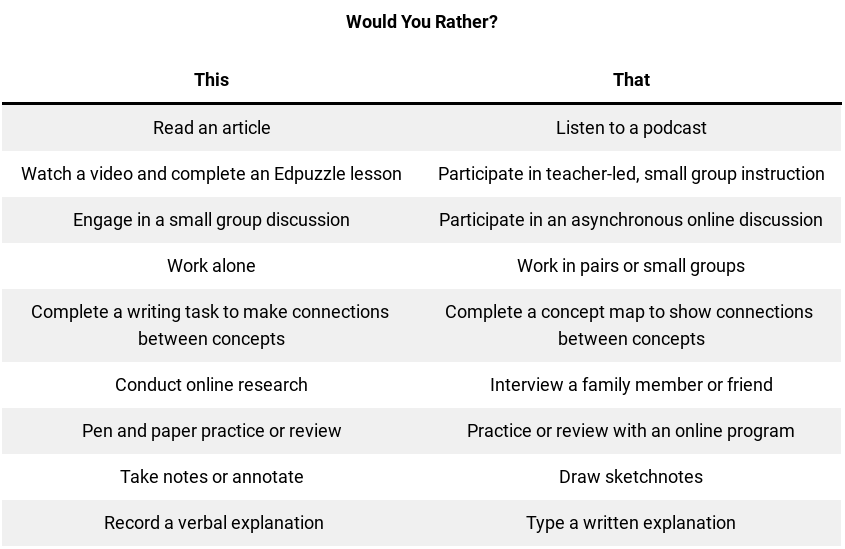My children love “would you rather” questions. Would you rather go to the beach or the snow? Would you rather eat a cookie or a brownie? Would you rather watch a movie or read a book? They enjoy being presented with two options and getting to choose one.
In a workshop last week, I was guiding a group through the process of designing a choice board. I love choice boards, but I know they take time to create. Time is a luxury most teachers do not have right now. It got me thinking…what if we began more simply with a “would you rather” format?
Could approaching the design, instruction, and facilitation of learning (in class, online, or a combination of the two) with a “would you rather” lens improve student motivation and engagement? I think it could.
Instead of a choice board with nine options, teachers can provide students with at least one choice between two options during the learning experience. That requires less time to prepare for, while still giving students a choice. Choice has been shown to improve retention, transfer performance, and motivation (Schneider, Nebel, Beege & Rey, 2018). It is worth our time to prioritize student choice, even if that choice is fairly simple.

Self-Determination Theory
Self-Determination Theory identifies three basic psychological needs that impact motivation–competence, relatedness, and autonomy (Deci & Ryan, 2000). Competence is the feeling that students can complete tasks successfully. If students choose how they engage with information, review concepts, work on tasks, or share their learning, they are more likely to feel competent in those endeavors.
Relatedness is the sense of connectedness to the other learners in a class community. Relatedness is trickier to achieve when students are learning online. The feeling of social isolation that some students experience online can negatively impact their motivation and desire to engage. Providing them with the choice to decide how they engage with one another may help them feel more connected to their peers.
Finally, autonomy, or the feeling of independence and ability to make decisions, is supported by choice. The more opportunities students have to make key decisions about their learning, the more likely they are to be motivated to lean into the learning. A student’s sense of autonomy and agency are enhanced when they are given a choice about how to engage with the content, learning activities, and each other.
An Experiment
When I work with teachers, I encourage them to treat their classrooms (physical or virtual) like a laboratory. Our goal should be to investigate, experiment, tinker, and learn to ensure that the learning experiences we are designing meet our students’ diverse needs.
What would happen if we commit to incorporating one choice into every lesson or learning experience for a month? How might that impact the students’ interest, engagement, and motivation?
I encourage teachers to try this 30-day experiment incorporating at least one “would you rather” choice into each lesson or learning experience. I would love to hear what you observe and hear from students. Ask them for feedback!


21 Responses
Thank you for sharing! Would you happen to have a link to slide resources available? I am an Adjunct Instructor and I’m going to use this strategy this week. Thank you for the inspiration! 🙂
Absolutely, Jennifer! The link below will prompt you to make a copy of the Google Slide deck.
https://docs.google.com/presentation/d/1oqcF7g6iE00CEixuIRQLVslp0pCXniDy_GOn8EKY0l8/copy?usp=sharing
Let me know if you have any issues accessing it.
Take care.
Catlin
Thanks for sharing, Catlin!
You’re welcome, Robyn!
I love this idea! I will be presenting at NCCE next month around student engagement and one of the sections is on choice. Could we share your slides as a one of our resources for participants in our session? It’s nice for people to have a visual of where to begin. Thank you so much!
Jen
Hi Jennifer,
Yes, you may share my slide deck with your participants as a resource.
https://docs.google.com/presentation/d/1oqcF7g6iE00CEixuIRQLVslp0pCXniDy_GOn8EKY0l8/edit
Good luck with your presentation!
Take care.
Catlin
I’m trying to incorporate as much choice in my lessons – for the would you rather where you ask students to “record an explanation” what’s the best way I can have students quickly and easily record a verbal explanation – I want to provide them instructions. I have an article they are reading and they have to answer questions along the way… I would love for them to be able to record their voices and somehow embed them right in the google doc?
Hi Kim,
If your students used Mote (a Chrome Extension), I believe they could record short (less than 30 seconds) responses right inside their Google Docs.
Catlin
Hi Catlin,
Your ability to understand the major barriers facing our teachers and students (no matter the subject matter!), explain ways to dissolve said barriers, and make everything super user friendly is truly a gift! Thank you for all your contributions to the educator community. Dr. Catlin Tucker = a huge positive to our crazy 2020!
Quick question – do you have any super hero blended learning math friends that I should be following as well?
Thanks!
Meg
Hi Meg,
Thank you for the kind note! I’m thrilled to hear my resources have been useful. I would follow @Sarah_Dunn_2 and @alicekeeler. I also put together a spreadsheet with subject specific follows that came from recommendations online. The math sheet has a lot of talented folks worth following!
Twitter follows by subject area
Take care.
Catlin
Thank you! Love this idea. So simple way to give student agency.
As a freshman in college and majoring in elementary education, I am learning on connecting with other teachers and educators to gain more knowledge on using technology in the classroom and getting ideas to create my own classroom. I thought this idea of using would you rather with finding ways children are more engaged in was great, and would want to use something like this. I was wondering what other educators could I be following on like twitter to help me grow my ideas for a future class room! Thank you.
Hi Josie,
I put this spreadsheet together for my teacher candidates. I hope it is helpful to you as you build your professional learning network.
https://docs.google.com/spreadsheets/d/1Txo6KQ1vUvYsqm7YRghRLkyfAdxYc1Vr2bEaHnmTBXs/edit#gid=0
Take care.
Catlin
Hi Catlin,
I love this so much! I’m a high school Title 1 teacher and my students struggle with academics every single day. The greatest struggle is often just motivation to get going at all. I love your idea to incorporate choice at least once in every lesson. I think that could truly help build motivation and engagement, as nearly all of them feel as though they have no control over anything in their lives. By allowing them to control some aspect of their learning, we give them more power and maybe we could get more out of them.
Thanks for sharing!
You’re welcome, Jenna! So glad this was helpful. I appreciate the note 😊
Take care.
Catlin
Can you limit choice boards by only using 3 options instead of 9? 9 different options seems overwhelming to grade!!! 3 options and having the students complete 2/3 sounds better and then maybe move up to 6 or 9. Or am I over thinking this??!!
Hi Patt,
Yes, you can absolutely limit your choice to 3 if that feels more doable! Some choice is better than no choice 🙂
Catlin
I recently gave my fifth graders three songs for our Spring concert. I told them one had to go. After two weeks of reviewing the songs, the students voted. They got to choose two of the songs for their concert. This worked very well. The seemed happy to be in control. I will definitely continue to do this.
That’s wonderful, Gary! I love that you are engaging your students in this way and providing them with meaningful choice.
Take care.
Catlin
Good evening!
I am collecting resources with a student-centered learning focus to share with educators across Pennsylvania. These would be free and I would give attribution back to you. Would you be okay with me sharing this post and the slides?
Hello Kendy,
Yes, you are welcome to share them with attribution! Here is the link to the deck.